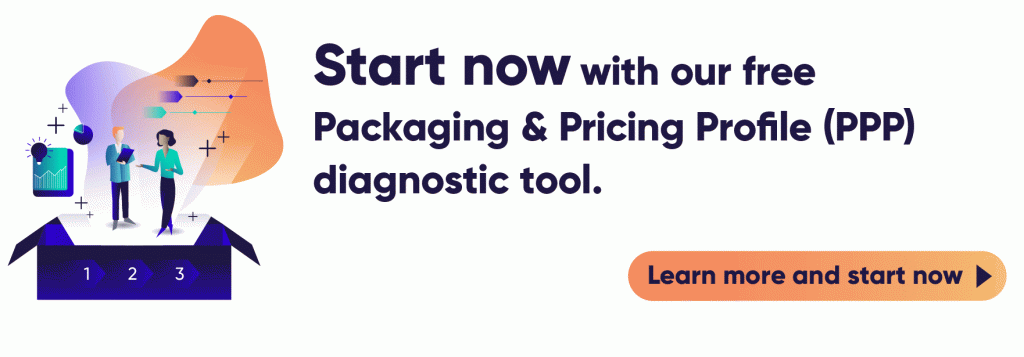When it comes to pricing, there is a lot of untapped potential. According to a Bain study, a stunning 78% of B2C companies are convinced their pricing decisions can be improved! A thought-out pricing strategy can improve your pricing decisions, and simultaneously help you to monetise on this potential.
Johan Maessen, a pricing expert who has worked with dozens of companies to define their pricing strategies, says that the most successful companies have a practical pricing strategy. These strategies are mostly successful because they are based on a defendable framework and periodic revisions. With Johan’s expert advice, we will take a look at the benefits and steps involved in setting up a practical pricing strategy. Although there is no one-size-fits-all solution, the building blocks of such a pricing strategy are often similar.
What are the benefits of a pricing strategy?
A well thought out pricing strategy sets a business up for success by steering it in the desired direction. Truly understanding all of the pricing levers that determine your price allows you to demystify the role of pricing in your organisation and enable actually managing it. Pricing levers are elements that have an influence on the price that your customer eventually pays. In a more traditional setting, this can include material costs, volume bonuses, and freight charges. In a more dynamic price setting process, it can also include elements like product life cycle status, stock information, and competitor pricing.
Having a solid pricing strategy also helps you manage through volatile market circumstances. “With a pricing strategy, the chances that you’ll veer off-course are significantly reduced, which delivers commercial peace of mind”, Johan explains. And if something does change in your business or market, having a strategy in place will help you decide on where you need to make adjustments, to get back on track swiftly.
But how exactly do you go about creating this ‘tailor-made’ pricing strategy? We will take you through the different phases to get you started:
- Defining your desired price positioning in the market
- Understanding price levers and developing a framework
- Determining your business rules
- Evaluating and iterating to improve

Phase 1: Defining your desired price positioning in the market
Developing your pricing strategy begins with assessing your current situation in the market. Before you start developing your pricing strategy you need to have a deep understanding of the market and your pricing power. Are you the market leader that sets the prices, or do you follow a certain competitor, and how? There are 3 main areas of interest during this first phase:
Taking into account overarching strategic company objectives
A start-up company for example often has a strong customer growth objective. On the other hand, a large corporate with already a stable customer base maybe wants to increase profitability. This overarching direction has an influence on the pricing strategy.
Looking at the current market and its dynamics going forward
Are you active in a mature market with limited innovation or is the market very dynamic with continuous product innovations, and how is this expected to evolve going forward? These questions are relevant to address to determine the degrees of freedom of your pricing strategy.
Considering competitors and finding out where you are positioned in terms of pricing vs. value delivery
Identify your main competitors, and determine where you want to be positioned based on price vs. value delivery. Subsequently, compare the outcome with your current positioning. If you know where you are right now, and where you are heading, it’s easier to actually get there.
Related article: [Discussing Pricing Strategies with Johan Maessen]
Phase 2: Understanding price levers and developing a framework
You’ve analysed the market and determined your desired positioning. Now it’s time to identify all of the pricing levers that are relevant in the price setting process.
For example, Johan explains that for an electronics retailer, the product status is an important factor. In case a product is temporarily difficult to re-stock, the retailer would want to secure the monetisation of the available stock at a good price. Alternatively, for retailers with fresh products, shelf life is an important price lever. When the expiration date comes closer, the price should go down to prevent products from remaining unsold and go to waste. The combination and right order of these ‘levers’ eventually determines your pricing framework, as they trigger the different instances where your prices might need to change. To support a dynamic price setting framework often pricing software is used to keep price updates manageable.
Another important factor when developing your pricing strategy is to consult internal stakeholders who have involvement in the price setting process. Share information on the current way of working, market dynamics, competitors and identified price levers. Johan explains that he encourages clients to dedicate time to this, and secure everyone is on the same page. It is often a very insightful activity and surely improves the final result.
The activities above will help you to create the first draft of a pricing framework that suits your company’s way of doing business. It includes the price levers that are relevant for you, but it doesn’t produce prices yet. This is covered in the next phase.
Phase 3: Determine business rules
To build a pricing strategy that is actionable, you need to go one step further and determine business rules. Business rules are defined here as the logic that you want to apply to an individual price lever.
For example, “the business rule for the aforementioned price lever shelf life could be: If the shelf life is less than 2 days, the price will decrease with 20%” explains Johan. Again, to be able to adjust prices on such a business rule, you need to have your data available, organised and supported by pricing software. But it can also be less dynamic, for example, for the price lever “volume bonus” for a software company that sells functional modules per module on a subscription base model: “The customer pays 5% less for the second module and 10% less for each additional module that is purchased”.
As you can see, with the logic of the business rule the prices can be actually set, and your pricing framework comes to life. While developing the business rules, keep into account your findings of phase 1, as they provide valuable direction for the exact height of the price levers.
Phase 4: Evaluating and iterating to improve
Here it is where the real impact is made. The steps above are not a once-off exercise but part of an iterative process. Only continuous monitoring of market developments, identifying new pricing levers, and adjusting your business rules accordingly, will keep you ahead of your competition.
Setting up a pricing committee that comes together regularly is a good first step to implement this in your organisation. In the longer run, it is also important to think about your organisational set-up and secure the structural build-up of pricing capabilities. This investment pay-off is confirmed by a McKinsey article in which a profit increase of up to 25% is predicted through a structural price advantage.
On a closing note, Johan wants to remind us that pricing is the most impactful profit lever. He confirms that, from his experience, the right attention to the pricing domain can lead to double-digit profit improvement. In order to feel more comfortable with your own pricing decisions going forward his final advice is to keep it simple at the start, and gradually evolve the pricing strategy over time.
Helpful resources
Bain, “The Pricing Is Right: Lessons from Top-Performing Consumer Companies”, September 24th, 2019
McKinsey, “Building a better pricing infrastructure”, August 2010












